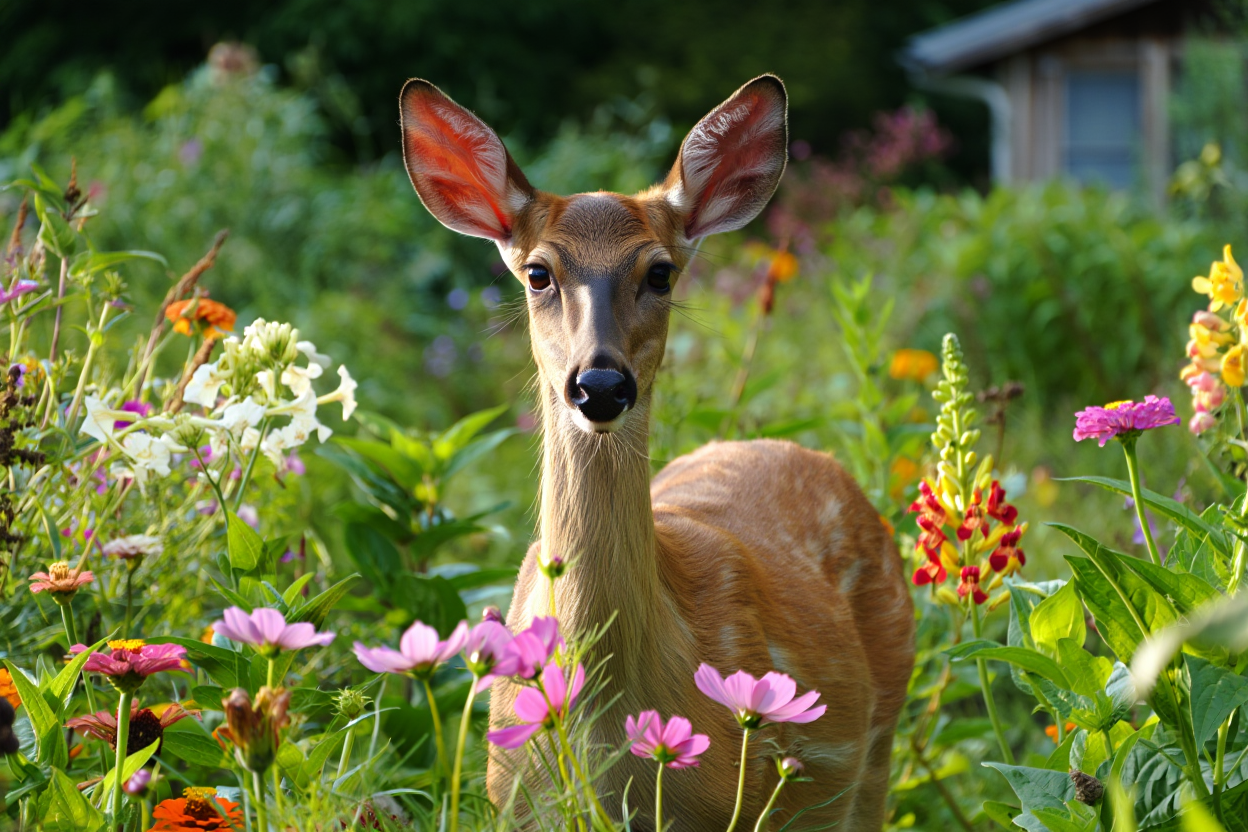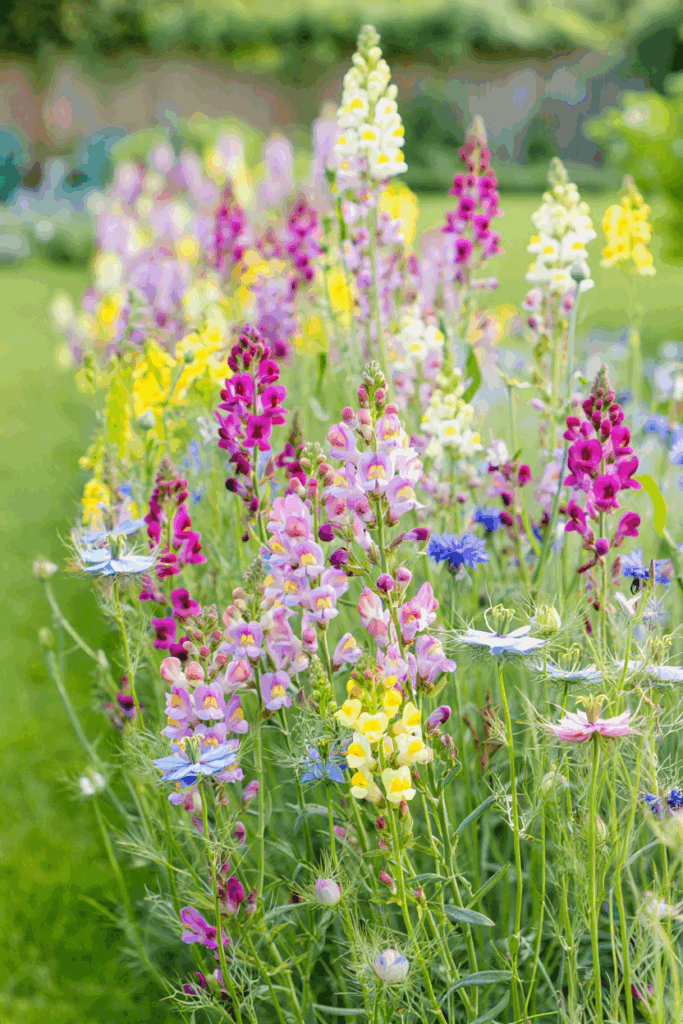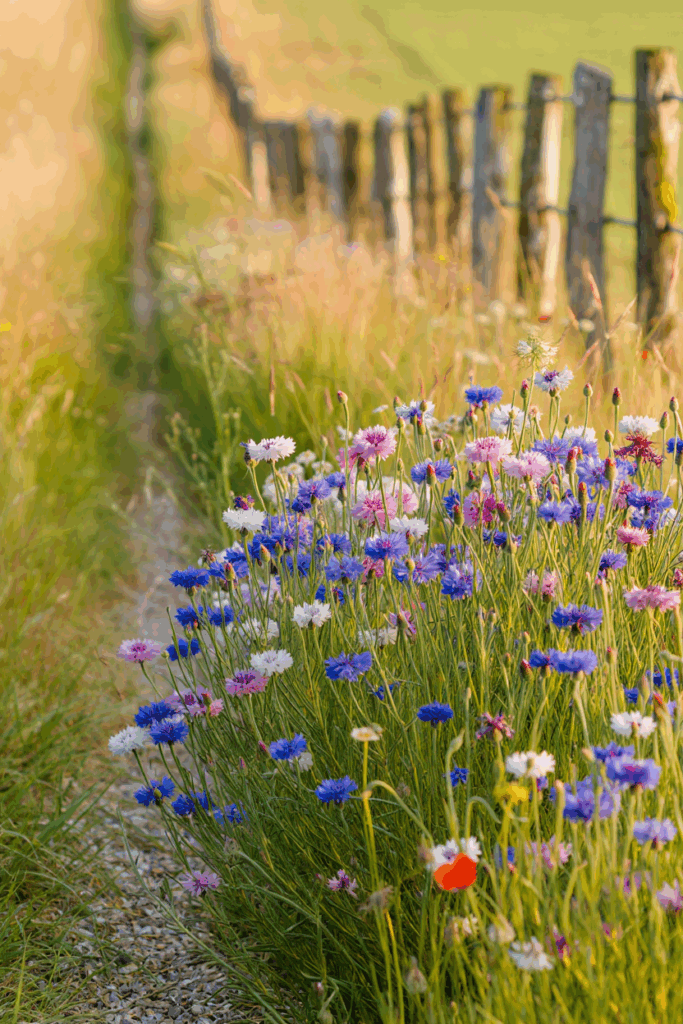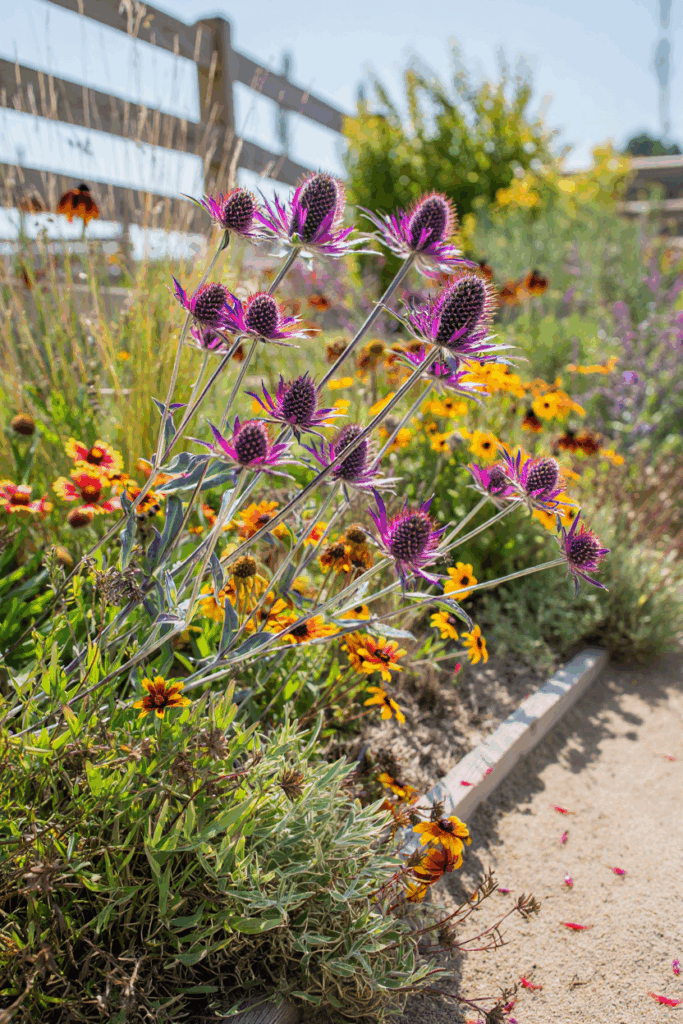
If you’ve ever tiptoed out to the garden in early spring, clippers in hand, dreaming of armfuls of fresh blooms — only to find stubs where your flowers once stood — you know there’s nothing quite as discouraging as evidence of a midnight deer feast.
Those gentle-eyed visitors may look innocent in the morning light, but for anyone growing flowers to cut, they’re heartbreak in disguise. We spray, we fence, we mix up every homemade deterrent we can find — only to watch another bouquet idea literally disappear overnight.
For years, I tried everything short of standing guard myself. Then I realised the trick wasn’t to fight nature, but to work with it — to choose flowers that deer simply don’t fancy. Some are too fragrant, some too prickly, and a few just taste far too bitter to bother with. Once I began planting those resilient annuals, the change was remarkable. The garden stayed intact, the deer moved on, and the vases filled again.
What I love most is how these flowers quietly defend as they delight. Planted at the edge of beds, they form a natural barrier — a living border that protects more tempting plants while providing armfuls of colour for cutting. They’re as beautiful as they are practical, thriving through cool weather and rewarding every snip with fresh stems for the house.
So whether your garden borders a meadow or a driveway, this autumn is your chance to plant smarter. These twelve deer-resistant annuals promise the best kind of abundance — flowers for your home, peace for your garden, and not a single bite mark in sight.
1. Annual Linaria (Linaria maroccana)

There’s something quietly cheerful about Annual Linaria, sometimes called Baby Snapdragon or Toadflax. Its slender stems carry clouds of tiny blooms that look like miniature snapdragons in watercolor shades of violet, rose, lemon, and white. Each plant is a mist of color in early spring — light, airy, and far tougher than its delicate look suggests. Best of all, deer completely ignore it. The fine, slightly aromatic foliage and narrow stems simply don’t appeal to browsing mouths.
Native to Morocco and the Mediterranean, Linaria maroccana thrives in cool weather and lean, well-drained soil — much like larkspur or poppies. Sown outdoors in late autumn or very early spring, it germinates easily after a chill and grows quickly once the days lengthen. The plants bloom freely for weeks, filling the garden with movement and soft color before heat sets in.
For cutting, Linaria brings a natural grace to arrangements. The wiry stems mix beautifully with tulips, stock, and nigella, adding texture and airiness without bulk. Harvest when half the florets are open, and you’ll be surprised by how long they last in the vase. Whether you grow it as a border filler or a gentle bridge between showier flowers, Linaria proves that even the lightest touch in the garden can stand firm against deer.
2. Larkspur (Consolida ajacis)

There’s something quietly magical about larkspur — how a scattering of seeds in November can turn, almost by accident, into tall, romantic towers of bloom by spring. I love watching their feathery green shoots appear just as the rest of the garden still feels asleep. They’re proof that some of the most graceful flowers are also the toughest, thriving on frost, neglect, and the kind of cool weather most annuals can’t handle.
And the best part? Deer want absolutely nothing to do with them. The plants contain natural alkaloids that make them bitter and mildly toxic, so even in places where deer treat flower beds like salad bars, larkspur stands untouched. If you’ve ever lost tulips or snapdragons to nighttime grazers, this one feels like sweet revenge — beauty that bites back (in a good way).
Direct sow where you want them to bloom, since they don’t transplant well. In Zones 7–10, November sowing gives you stronger, earlier spikes; farther north, early-spring sowing works just as well once the soil can be worked. Cut when the bottom florets are open and the top buds are still tight — they’ll hold their elegance for a week or more indoors, reminding you that resilience can look downright romantic.
3. Orlaya grandiflora (White Lace Flower)

If you love the delicate look of Queen Anne’s lace but need something deer-resistant and better-behaved, Orlaya grandiflora is your plant. Its lacy white umbels hover like soft snowflakes above ferny foliage, adding that airy, romantic touch every cut-flower garden needs — and deer want nothing to do with. The slightly aromatic leaves make it unappetizing to grazers, so even in deer-heavy areas, its feathery stems stay untouched.
Orlaya thrives in cool conditions and is one of the best annuals to sow in late fall. Scatter seeds in November, and they’ll germinate as winter fades, producing sturdy spring plants that bloom from late spring well into early summer. Unlike Queen Anne’s lace, it doesn’t spread aggressively or become weedy — it simply blooms generously, then quietly fades, often reseeding in the same spot for next year.
As a cut flower, Orlaya is a quiet star. The blooms last a week or more in the vase and mix beautifully with everything from poppies to snapdragons. Its branching stems fill bouquets without overpowering them, bringing lightness and grace to any arrangement — and all without a single bite from deer.
4. Bupleurum (Bupleurum rotundifolium)

Bupleurum might not have the name recognition of poppies or cosmos, but seasoned cut-flower growers swear by it. Its chartreuse blooms — really clusters of tiny yellow-green flowers framed by leaf-like bracts — add a luminous, almost ethereal glow to spring arrangements. Think of it as the florist’s answer to eucalyptus: soft, textural, and incredibly long-lasting in the vase.
And when it comes to deer, Bupleurum is about as safe as it gets. The foliage has a bitter, medicinal taste that deer instinctively avoid, so even in browse-heavy areas you can count on pristine stems. Because it’s a cool-season annual native to the Mediterranean, it thrives in the same conditions deer dislike — dry air, lean soil, and chilly nights.
Sow seeds in November in Zones 7–10 so they can settle through winter, or start in early spring elsewhere. Once the roots take hold, Bupleurum needs little care beyond good drainage and full sun. It blooms steadily from late spring into early summer and holds beautifully after cutting — both in fresh bouquets and when dried for texture.
5. Stock (Matthiola incana)

Few flowers bring as much fragrance to a cool-season cutting garden as Stock. Its tall spikes of densely packed blooms come in every pastel shade imaginable — rose, lilac, cream, white — and release a spicy-sweet scent that perfumes the entire garden. Don’t let its romantic look fool you: Stock is remarkably cold-tolerant and thrives in the crisp weather of late fall and early spring, making it an excellent November planting choice in Zones 7–10.
Better yet, deer won’t touch it. The foliage has a faintly bitter, slightly fuzzy texture that grazers find unappealing, so even when everything else gets nibbled, your Stock stands tall. It’s one of those rare cut flowers that delivers both elegance and reliability, perfect for growers in deer-heavy regions who want fragrance without frustration.
Start seeds indoors or direct sow in a protected spot once temperatures cool. Plants prefer rich, well-drained soil and full sun, and they bloom best before the weather turns hot. Cut spikes when the first few flowers open for the longest vase life — they’ll perfume a room for a week or more.
6. Strawflower (Helichrysum bracteatum)

Strawflowers are the definition of cheerful endurance — papery petals that never wilt, colors that never fade, and blooms that seem to laugh at heat, wind, and deer alike. Their crisp, almost dry texture feels like they’re already preserved, which is part of their charm. In shades of tangerine, rose, lemon, and bronze, they light up the garden just when many other annuals are starting to fade.
I started growing strawflowers years ago because deer were eating everything else — and I’ve never looked back. The stiff, rustling petals and slightly resinous leaves make them completely unappealing to deer, even when the rest of the bed has been nibbled clean. They’re one of those bulletproof annuals that deliver armloads of blooms without coddling — perfect for busy or rural gardeners.
In Zones 8–10, sow in November for early color; farther north, start indoors in late winter and transplant once frost has passed. Cut blooms just as the centers begin to open for the best shape, or hang them to dry — they’ll hold their vivid color for months, making them a staple for dried wreaths and arrangements.
7. Bachelor’s Button (Centaurea cyanus)

Bachelor’s buttons are the kind of flower that make a garden feel happy without even trying. Those bright, frilly blooms in shades of cobalt blue, soft pink, and snow white seem to float above their silvery foliage, catching every bit of spring light. They’re easy, nostalgic, and cold-hardy enough to sow right into November soil — the perfect “set it and forget it” annual for fall planting.
And if you’re gardening where deer roam, you’ll love them even more. The fine, fuzzy leaves and slightly bitter taste make them one of the most reliably deer-resistant cut flowers you can grow. Deer may nibble nearby pansies or tulips, but they leave bachelor’s buttons untouched — a small miracle in many gardens.
They thrive in lean, well-drained soil and full sun, and they don’t need much pampering. Direct sow where you want them to grow, since their taproots dislike transplanting. Once they start, they’ll bloom for weeks, attracting bees and butterflies while giving you armfuls of stems for fresh bouquets. Cut often, and they’ll just keep coming.
8. Snapdragon (Antirrhinum majus)

There’s a reason every serious cut-flower grower plants snapdragons — they’re as tough as they are beautiful. Those stacked, dragon-mouthed blooms in soft pastels and bold jewel tones bring early color when few other flowers are blooming. When sown in November in mild zones, snapdragons quietly root through winter, rewarding you with strong, floriferous stems by spring. Even light frost won’t faze them; in fact, cool weather helps them develop richer color and longer-lasting blooms.
And if you battle deer, snapdragons are a gift. The foliage and stems contain compounds that make them taste bitter and unpleasant to grazers, so deer usually pass them by without a second glance. I’ve had entire beds of tulips mowed down while the snapdragons standing right beside them stayed perfectly untouched — it’s that reliable.
Plant them in full sun and well-drained, fertile soil, and pinch the growing tips early to encourage branching. Cut the spikes when the lower flowers start to open, and they’ll last over a week indoors. Snapdragons also rebloom after cutting, making them one of the longest-performing cool-season annuals you can grow.
9. Calendula (Calendula officinalis)

Calendula brings warmth to the garden the way a hearth brings warmth to a cold room. Its golden, honey-toned blooms glow even on gray days, standing tall through cool winds and late frosts that send most annuals running. The plants themselves are sturdy and self-assured — a little sticky to the touch, faintly herbal in scent, and endlessly generous once they start to flower.
Deer, thankfully, want no part of them. The same resinous oils that give calendula its earthy aroma also make it unpalatable to grazers. In deer-prone gardens, that alone feels like a luxury — color and abundance you can actually count on.
Give calendula full sun and well-drained soil, and it will bloom for months on end if you keep cutting. Each flower feels like a pocket of stored sunlight, perfect for bringing brightness indoors. Easy, cheerful, and quietly resilient, calendula is the kind of plant that never shouts for attention — it simply earns it.
10. Eryngium leavenworthii (Leavenworth’s Eryngo)

If you garden where deer are a constant presence, Eryngium leavenworthii feels like sweet revenge. Deer won’t touch it — not a nibble, not a bite. The stiff, spiny leaves and metallic blooms are too tough, too prickly, and too resinous for grazing. While other flowers vanish overnight, this one stands defiant, gleaming violet-blue in the summer sun like it’s armored for battle.
Native to the southern Great Plains, Leavenworth’s eryngo thrives on neglect — full sun, dry soil, and heat that would flatten most annuals. Sow seeds directly outdoors in late fall or very early spring; they need winter’s chill to break dormancy. Once established, the plants handle drought with ease and produce an ever-deepening display of steel-blue bracts and cones from midsummer into fall.
For the cutting garden, eryngo is a standout. The flowers last for weeks in fresh arrangements and dry beautifully, holding their electric color long after the season ends. Rugged, sculptural, and pollinator-rich, it’s proof that some of the most deer-proof plants are also the most striking.

Written By
Amber Noyes
Amber Noyes was born and raised in a suburban California town, San Mateo. She holds a master’s degree in horticulture from the University of California as well as a BS in Biology from the University of San Francisco. With experience working on an organic farm, water conservation research, farmers’ markets, and plant nursery, she understands what makes plants thrive and how we can better understand the connection between microclimate and plant health. When she’s not on the land, Amber loves informing people of new ideas/things related to gardening, especially organic gardening, houseplants, and growing plants in a small space.
